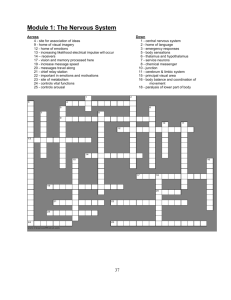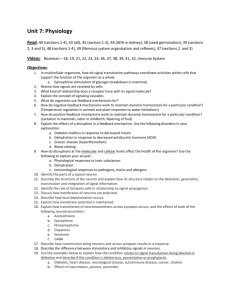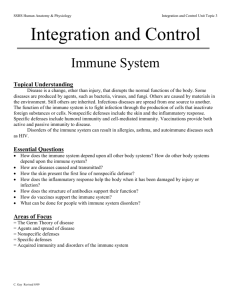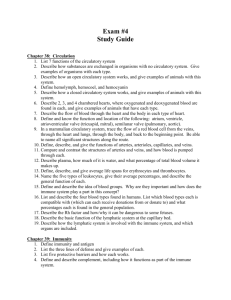The Biopsychosocial Model, Methodology, and Systems of the Body 1
advertisement
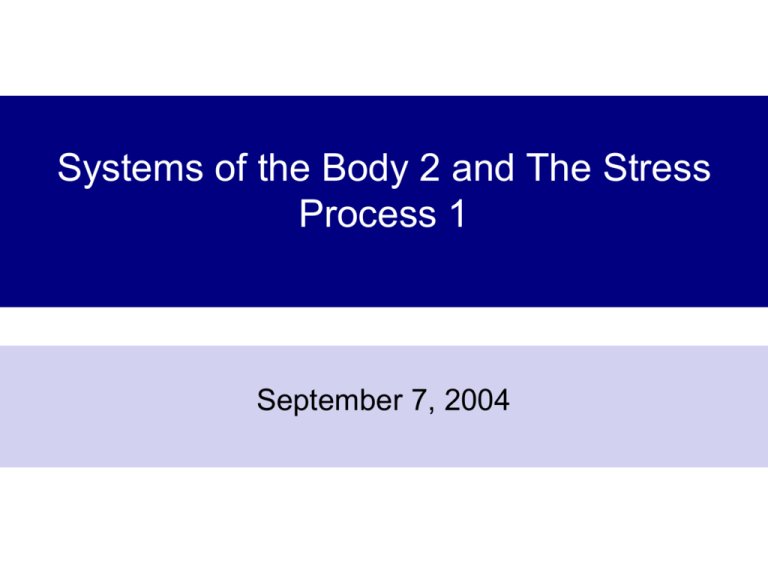
Systems of the Body 2 and The Stress Process 1 September 7, 2004 Overview Systems of the Body • Digestive System • Renal System • Reproductive System • Immune System Methodology The Stress Response The Digestive System Digestion – the conversion process in which food is changed into a form which can be used by cells. Nutrients are supplied for growth and tissue repair. The Digestive System • Bolus – food lubricated by saliva and formed into a soft, rounded lump. • Bolus passes through esophagus to stomach where gastric juices further the digestive process. • Pancreas secretes juices into duodenum to break down proteins, carbohydrates and fats. • Pancreas produces insulin to facilitate the entry of glucose into bodily tissues. • Liver produces bile to break down fats. • Absorption of food takes place primarily in the small intestine. • Food residue passes into large intestine and then rectum. The Digestive System Disorders • Gastroenteritis – inflammation of the lining of the stomach and small intestine • Diarrhea – lining of the small and large intestine does not absorb water and digested food • Dysentery • Peptic Ulcer – sore in the lining of the stomach or duodenum • Gallstones – stones in the gallbladder made of cholesterol, calcium, bilirubin, and inorganic salts • Appendicitis – accumulation of bacteria in the appendix • Hepatitis – a contagious disease causing the inflammation of the liver The Renal System • Structures - kidneys, ureters, urinary bladder, and urethra • Kidneys regulate bodily fluids, primarily they produce urine. • Urine consists of surplus water, surplus electrolytes, waste products from metabolism of food, and surplus acids. • Sodium and Potassium are key electrolytes. The Renal System Disorders • Urinary tract infections – can be caused by bacteria • Acute glomerular nephritis – inflammation of the glomeruli of the kidneys; usually a secondary response to a Strep infection • Tubular necrosis – when cells in the tubules of the kidneys are destroyed then acute renal shut down can occur. The Reproductive System • Each female has two ovaries, which produce estrogen and progesterone. • One of the ovaries produces an ovum (egg) each month • If the ovum isn’t fertilized by a sperm then it is flushed out of the uterine cavity with the uterine endometrium and its blood vessels (menstruation) • In males, the pituitary controls production of testosterone, which is produced by the interstitial cells of the testes. • Testosterone brings about the production of sperm and the developing of male secondary sex characteristics. • One sperm may fertilize the ovum, which then travels down the fallopian tube and embeds itself in the uterine wall. • The implanted embryo will develop over nine months. The Reproductive System Disorders • Sexually transmitted diseases - herpes, gonorrhea, syphilis, genital warts, Chlamydia, AIDS • STDs may result chronic pelvic inflammatory disease in women. • Reproductive system is vulnerable to testicular cancer and gynecologic cancers. • 8% of U.S. couples have fertility problems The Reproductive System Genetics and Health • Genetic material for inheritance lies in the nucleus of the cell in the form of 46 chromosomes. • Studies of genetically-related family members, twins, and adopted children are important in determining the etiology and genetic influences of diseases. • Psychologists counsel couples regarding genetic testing and the psychosocial ramifications. The Immune System • Infection - The invasion of microbes and their growth in the body. • Four routes of infection • Direct Transmission - contact • Indirect Transmission – environmental transmission • Biological Transmission – transmitting agent involved in the disease process infects a target • Mechanical Transmission – carrier transmits disease The Immune System The Course of Infection Incubation period • Period of nonspecific symptoms • Acute phase • Fatality OR • Period of decline during which invading organisms are expelled Infections may be localized, focal, or systemic. Primary infections may lead to secondary infections. The Immune System Immunity • The body’s resistance to injury from invading organisms. • Temporary natural immunity when breast fed. • Natural immunity is acquired through disease. • Artificial immunity– vaccinations/inoculations • The body has nonspecific and specific immune mechanisms. • Nonspecific – general responses to any type of infection or disorder • Specific – targeted to fight particular microorganisms The Immune System Disorders • AIDS – progressive impairment of immunity • Cancer – depends heavily on immunocompromise • Autoimmunity – a condition characterized by a specific humoral or cell-mediated immune response that attacks the body’s own tissues. • Certain forms of arthritis • Multiple sclerosis The Scientific Method Theory: Based on observations Accept or Reject Hypothesis Hypothesis: Predictions about what will happen Normal Science Paradigm Analyze Data Data Collection Methodology in Psychology Empiricism • Measures observable phenomenon Theory Formulation and Hypotheses Testing • Researchers observe every day phenomena. • These observations form the basis of scientific theory and inquiry. Methodology Experiments Randomized Clinical Trials Correlational Studies Comparing changes in variables Looking forward, longitudinal research Looking backward Prospective Designs Retrospective Research Methodology Experiment A study where there is random assignment to treatment groups in an intervention focused on exercise and weight loss Correlation A study of the relationship between cultural identity and physical symptoms Prospective A study following the physical and mental health indicators outcomes of cancer patients 6 months, 1 year, and 2 years after chemotherapy Retrospective A study examining the past coping strategies of cardiac patients Experimental Research • • • • Random assignment to conditions Manipulate independent variable to determine causality Test statistically for significant differences between groups Quasi-experimental methods – When individuals cannot be randomly assigned to groups Definitions Independent Variable – what the researcher manipulates Dependent Variable – the outcome (what changes based on the manipulation of the independent variable) Internal Validity – the degree to which the conditions of the experiment are causing the effect External Validity – generalizabilty of results to other contexts Types Laboratory studies Clinical Trials Strengths Limitations Evidence for causation Generalizability Generalizability – real world applications Experimental Research Experimental Design Participants are randomly assigned to treatment groups in a one-month intervention focused on exercise and weight loss Independent Variable Group 1 - Exercise Every Day Group 2 – Exercise no more than once a week Dependent Variable Weight Loss After One Month Weight Loss After One Month Correlational Research • • • • Systematically measures the relationship between variables Correlation coefficient values (r) between -1, 1 Test for significant linear relationships between variables This will be affected by sample size • In larger samples relationships may be significant with a relatively small r value. Types Surveys Randomly selected populations Strengths Real World Context May be most expedient method Limitations Correlation does not equal causation Prospective Research Prospective A study following the physical and mental health indicators outcomes of cancer patients 6 months, 1 year, and 2 years after chemotherapy Type Self-report over time Strengths Can examine changes over time Relatively non-invasive Limitations Accuracy of self-report Many factors over time effect determination causality Retrospective Research Retrospective Research A study examining the past coping strategies of cardiac patients Type Self-report Retrospective recall Strengths Examines patterns of past behavior in the context of a specific event Limitations Accuracy of memory and self-report Limited determination of causality Stress A negative emotional experience accompanied by biochemical, physiological changes that are directed either toward altering the stressful event or accommodating to its effects (Baum, 1990) • Stressful events are called stressors • • • • Sitting in traffic Bad relationships Job interviews Death in the family • Perception affects the degree of stress experienced. Stress Personal Resources Personal Resources • Sufficient to meet demands: Low Stress • Not sufficient to meet demands: High Stress Stress: Fight or Flight Response (Cannon, 1932) When an organism perceives threat • Sympathetic nervous system is aroused • Endocrine system is aroused • Organism is mobilized to attack the threat or to flee from the threat • Adaptive – allows quick response to threat • Harmful – unabated stress is harmful to the organism physically and psychologically Stress General Adaptation Syndrome (Selye, 1956) • Nonspecific Response - The body responds to stress with the same physiological reactions Stress Resistance Normal level of Resistance Alarm Exhaustion Stress General Adaptation Syndrome (Selye, 1956) Three Phases in reacting to a stressor • Alarm: The body’s first reaction • Resistance: Occurs with continued exposure • Exhaustion: Physiological resources are depleted Stress General Adaptation Syndrome (Selye, 1956) Criticisms of the Model • Limited role given to psychological factors • Responses to stress are influenced by individual difference, perceptions, and preexisting physical and mental health • Stress is assessed as an outcome Stress Cognitive (Psychological) Appraisal (Lazarus, 1968; Lazarus & Folkman, 1984) Two step process: Primary appraisal process – What is at stake in the stress situation? • Is this event positive? • Is this event neutral? • Is this event negative? • Has harm already been done? • Is there a threat of future damage? • How challenging is the event, that is, can I overcome it or even profit from it? Stress Secondary Appraisal – What are my coping and psychological resources in this situation? How does the individual address the: • Harm • Threat • Challenge Stress Tend and Befriend (Taylor et al., 2000) • Model of affiliative responses to stress • The sympathetic arousal underlying fight-orflight may be down-regulated in females leading to nurturing behavior • Females’ responses to stress evolved to care for self and for offspring Stress • Oxytocin may be significant in female responses to stress • Animals and humans with high oxytocin levels are calmer, more relaxed, more social, and more maternal in behavior • Females rely more on social networks during stress Physiology of Stress SAM – Sympathetic adrenomedullary system Cannon’s “Fight-or-Flight” Response • Sympathetic arousal stimulates the medulla of the adrenal glands to secrete catecholamines (epinephrine and norepinephrine) • Blood pressure and heart rate increase, constriction of peripheral blood vessels, increased sweating Physiology of Stress HPA – Hypothalamus-Pituitary-Adrenocoricotropic Selye’s General Adaptation Syndrome • Hypothalamus releases corticotrophin-releasing factor (CRF) which stimulates the pituitary gland to release ACTH (adrenocorticotropic hormone) • ACTH stimulates the adrenal cortex to release glucocorticoids, especially cortisol Review figure 6.3 Physiology of Stress Effects of Long-Term Stress • Physiological changes are designed for fight of flight (short-term mobilization) • Long-term exposure to stress can have detrimental physical consequences. • Evidence supports that HPA activation may be more significant than SAM activation when individuals are under long-term stress. • Corticosteroids have immunosuppressive effects • Prolonged cortisol secretion is related to destruction of neurons in the hippocampus. Assessing Stress • Self-reports of perceived stress • Self-reports of life changes • Behavioral measures, such as task performance, under stress • Physiological measures, such as skin conductivity, heart rate, and blood pressure • Biochemical markers, such as elevated cortisol levels Dimensions of Stressful Events • Negative events are more likely to produce stress than are positive events. • However, people who hold negative views of themselves, positive life events appear to have a detrimental effect on health • Positive life events are linked to better health in people with high self-esteem • Uncontrollable, unpredictable life events are most stressful • Ambiguous events are more stressful Dimensions of Stressful Events • Overloaded people are more stressed than are people with fewer tasks to perform • More vulnerability to stress occurs in central life domains than in one’s peripheral life domains • The most important aspects of an individual’s life are more vulnerable to stress

